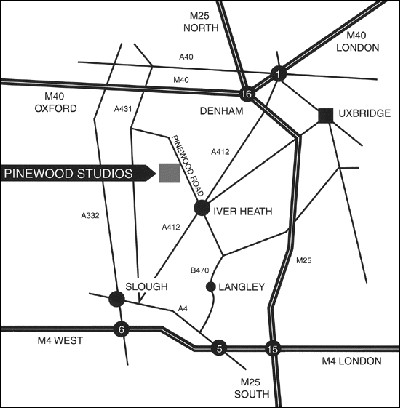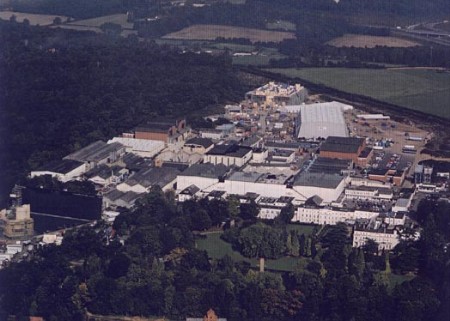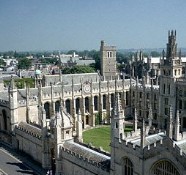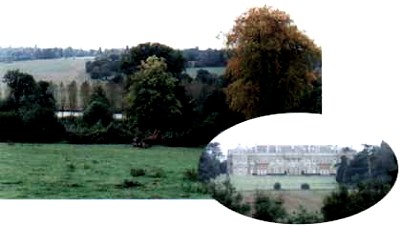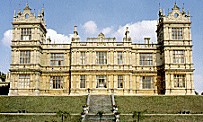Pinewood Studios
Oxfordshire
Luton Hoo Mansion
Old Royal Naval College, Greenwich
Mentmore Towers, Buckinghamshire
Pinewood Studios:
Pinewood was set up in 1936 by Arthur J Rank, C M Woolf and Charles Boot. They took over Denham Studios in 1939, resulting in the 'D and P' studios logo seen at the end of the films from that time. During the war, the Government commandeered the studios as offices, food stores and a Royal Airforce base. By 1947, Britain was in debt and £18m was going to US film producers. The Government slapped a tax of 75% on box office earnings of US films and the US retaliated with an embargo on films by their British counterparts. As a result, Rank was £16m in debt by 1949 and had to slash budgets, reduce salaries and lay off staff. In 1987, the studios became a "four waller", meaning that producers could hire freelance labour and production companies could come and go. The studios are still thriving. [From South Bucks District Council]
Feb 22, 2000 - "Pinewood Studios Sold to Investment Group" -
The Associated Press is reporting that London's legendary Pinewood Studios were sold to an investment group on Tuesday for $99.2 million. Here's an excerpt from the AP:
The studios, built by film mogul J. Arthur Rank in the 1930s, were sold to a group led by Michael Grade, former head of Britain's Channel 4. "People love to film at Pinewood, especially Americans,'' Grade told Press Association, the British news agency. "We want to keep attracting the Hollywood blockbusters, but also see more British films, TV programs and adverts made there.''
On Monday, the Rank Group sold its Odeon movie theater chain for $448 million. Rumors of a sale have surrounded Pinewood, based in Buckinghamshire, northwest of London, since 1996. The most recent figures, for 1998, show the studios made an underlying profit of $7 million on $21.2 million of turnover.
Pinewood hit financial difficulties shortly after its creation, but was requisitioned during World War II to make documentaries and entered its heyday soon after peace was declared. A run of James Bond hits, starting with "Dr. No'' in 1962 and running through last year's "The World Is Not Enough,'' secured its position as one of the world's most successful studios.
Recent movies made at Pinewood include Stanley Kubrick's final film, "Eyes Wide Shut,'' and "Entrapment,'' starring Sean Connery and Catherine Zeta Jones. It has been used in the past by such directors as Francois Truffaut and Charlie Chaplin.
Oxford / Oxfordshire -
The opening sequence was shot here:
Oxford is a unique and historic institution. As the oldest English-speaking university in the world, it lays claim to eight centuries of continuous existence. There is no clear date of foundation, but teaching existed at Oxford in some form in 1096 and developed rapidly from 1167, when Henry II banned English students from attending the University of Paris... Oxford early on become a centre for lively controversy, with scholars involved in religious and political disputes.
For more information about Oxford, go to " Welcome to the city of Oxford"
Luton Hoo - Mansion and Grounds:
Scenes in the 'lunatic ward' and art room were shot here:
The Robert Adam's Classical l8th century stone-built mansion, located in South Bedfordshire, dates back to 1767 but was remodelled by Sir Julius Wernher in 1903 after he had made his fortune from diamond mining. The house contains the Wernher art collection which includes Faberge jewels and Imperial robes worn at the court of the Russian Tsars, paintings by Titian and Rembrandt, rare tapestries and old English and French porcelain. The house is surrounded by a 1200 acre Capability Brown park.
In January 1999, Graeme Bateman, Managing Director of Sussex based Elite Hotels Limited, announced the acquisition of the prestigious Luton Hoo Mansion, together with 1000 acres of Parkland.
The Old Royal Naval College, Greenwich -
Serves as a room within the Palace of Versailles where Napoleon himself becomes familiar with the literature of Sade. Here, Childs and his crew were struck by the overwhelming sense of history, in a place designed by Christopher Wren and where King Henry VIII signed Queen Anne Boleyn's death warrant. [From the Quills press kit]
The Old Royal Naval College is the great baroque masterpiece of English architecture. Set in landscaped grounds on the River Thames in the centre of the Maritime Greenwich World Heritage Site, it will be at the heart of Millennium celebrations. The UNESCO designation recognises the site as being of "outstanding universal value", as Greenwich comprises the finest and most dramatically sited architectural and landscape ensemble in the British Isles.
Greenwich Hospital was established in 1694 by Royal Charter for the relief and support of seamen and their dependants and for the improvement of navigation. Sir Christopher Wren planned the site, described as "one of the most sublime sights English architecture affords", and during the first half of the eighteenth century various illustrious architects, such as Hawksmoor and Vanbrugh, completed Wren's grand design. The elaborate ceiling and wall paintings in the Great Hall (known as the "Painted Hall") were executed by Sir James Thornhill between 1707 and 1726. The chapel was restored by James "Athenian" Stuart after a fire in 1779.
In 1869 the Hospital was closed, and in 1873 the complex of buildings became the Royal Naval College , where officers from all over the world came to train in the naval sciences. In 1998 the Royal Navy left Greenwich and handed over responsibility for the site to the Greenwish Foundation. In the Autumn of 1999 the University of Greenwich began teaching in Queen Anne Court.
Mentmore Towers, Buckinghamshire -
Used as the mansion of Dr. Royer-Collard and his wife Simone.
Mentmore Towers was built in 1855 for Baron Meyer Amschel de Rothschild. He commissioned Sir Joseph Paxton and his future son-in-law G H Stokes to design the house. Although Paxton was not a trained architect he was a great favourite of the Rothschild family who were probably impressed by the Crystal Palace he built for the Great Exhibition of 1851 and his work at Chatsworth.
Paxton designed a vast building in Elizabethan style with great windows and a turreted roofline. The grand romantic mansion was a reflection of the immense wealth and power of the Rothchilds during the Victorian era.
At the end of the 19th century Mentmore Towers passed into the hands of Lord Rosebery. At that time the house contained a superb collection of fine furniture and works of art. Lord Rosebery made the house a magnificent centre of social life for the rich and influential.
In the 1970s the contents of the house were put up for sale. Although there was a public outcry at the possible loss to the nation of many important items, the auction went ahead and raised over £6,000,000.
The house was sold later to the Maharishi Mahesh Yogi and is now the headquarters of his University of Natural Law. At the present time the house is not open to the public.
